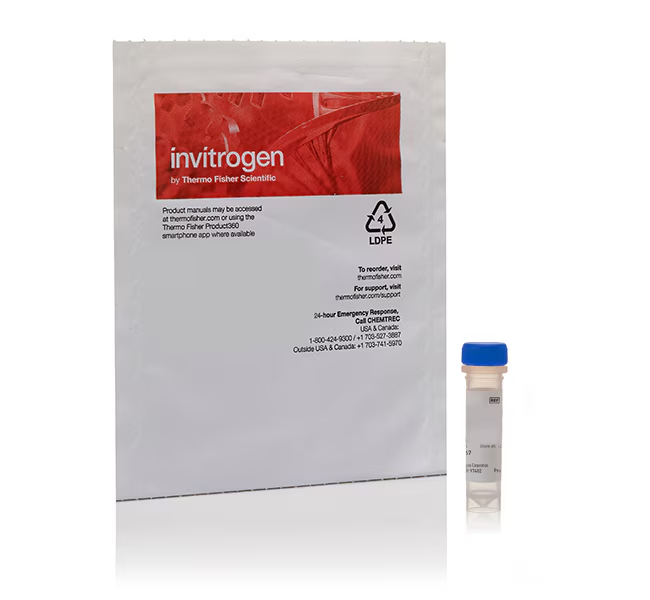pHrodo™ Red and Green Dextran, 10,000 MW, for Endocytosis (Invitrogen™)
Perform live-cell imaging of endocytosis faster and more accurately without the need for wash steps or quencher dye with pHrodo Red and Green dextran 10,000 MW conjugates. The pH-sensitive pHrodo Red and Green dextran conjugates are nonfluorescent in neutral environments but elicit bright red or green fluorescent signal in pH ranges 5–8, such as those in endosomes and lysosomes. These pHrodo-labeled dextrans can be multiplexed with other dyes and used in imaging, HTS, tracing, and flow applications.
Key Features
pHrodo Red Dextran (Cat. No. P10361) is a superior alternative to other fluorescent dextran conjugates (e.g., BCECF and tetramethylrhodamine [TRITC]) for live-cell imaging of endocytosis, the process whereby the plasma membrane buds to form membrane-bound vesicles (endosomes), which are then trafficked to various destinations within the cell. pHrodo Red Dextran has pH-sensitive fluorescence excitation/emission spectra of 560/585 nm, and its fluorescence emission increases in intensity with increasing acidity. This increase is particularly dramatic in the range pH 5–8, as commonly seen within endocytic vesicles. pHrodo Red Dextran is essentially dark in the extracellular environment; however, upon internalization, the dextran conjugate elicits a bright, red-fluorescent signal in the acidic environment of the endosomes. pHrodo Red Dextran can also be multiplexed with a wide variety of blue, green, and far-red dyes and reporters such as GFP, Fuo-4, calcein, NucBlue, CellEvent Caspase 3/7 green, Mitosox Green, and Mitotracker Deep Red, among many others.
pHrodo Green Dextran (Cat. No. P35368), like pHrodo Red Dextran, offers fast and accurate results for live-cell endocytosis and phagocytosis assays. pHrodo Green conjugates are non-fluorescent outside the cell at neutral pH, but fluoresce bright green at acidic pH ranges, such as those in endosomes and lysosomes. The pHrodo Green dye can be multiplexed with a wide variety of blue, red, and far-red dye reporters such as Mitosox Red, CellEvent Caspase 3/7 Red, NucBlue, RFPs, and Mitotracker Deep Red, among many others. pHrodo Green Dextran 10,000 MW conjugate can be used in cell imaging, high content screening, high throughput screening, and flow applications. For a broader selection of compatible dyes, please refer to the Cell Staining Tool or SpectraViewer.
Key applications using labeled dextrans:
There are many citations describing the use of labeled dextrans. Some of the most common uses include the following:
• Neuronal tracing (anterograde and retrograde) in live cells
• Cell lineage tracing in live cells
• Neuroanatomical tracing
• Examining intercellular communications (e.g., in gap junctions, during wound healing, and during embryonic development)
• Investigating vascular permeability and blood-brain barrier integrity
• Tracking endocytosis
• Monitoring acidification (some dextran-dye conjugates are pH-sensitive)
• Studying the hydrodynamic properties of the cytoplasmic matrix.
High manufacturing standards
We offer more than 50 fluorescent and biotinylated dextran conjugates in several molecular weight ranges. Dextrans are hydrophilic polysaccharides characterized by their moderate-to-high molecular weight, good water solubility, and low toxicity. They also generally exhibit low immunogeniticy. Dextrans are biologically inert due to their uncommon poly-(α-D-1,6-glucose) linkages, which render them resistant to cleavage by most endogenous cellular glycosidases.
In most cases, our fluorescent dextrans are much brighter and have higher negative charge than dextrans available from other sources. Furthermore, we use rigorous methods for removing as much unconjugated dye as practical, and then assay our dextran conjugates by thin-layer chromatography to help ensure the absence of low molecular weight contaminants.
Wide selection of substituents and molecular weights
Our dextrans are conjugated to biotin or a wide variety of fluorophores, including seven of our Alexa Fluor dyes and are available in these nominal molecular weights (MW): 3,000; 10,000; 40,000; 70,000; 500,000; and 2,000,000 daltons.
Order Codes
| Code |
Description |
| P35368 |
Catalog Number: P35368
Unit Size: 0.5 mg
Color: Green |
| P10361 |
Catalog Number: P10361
Unit Size: 0.5 mg
Color: Red |


